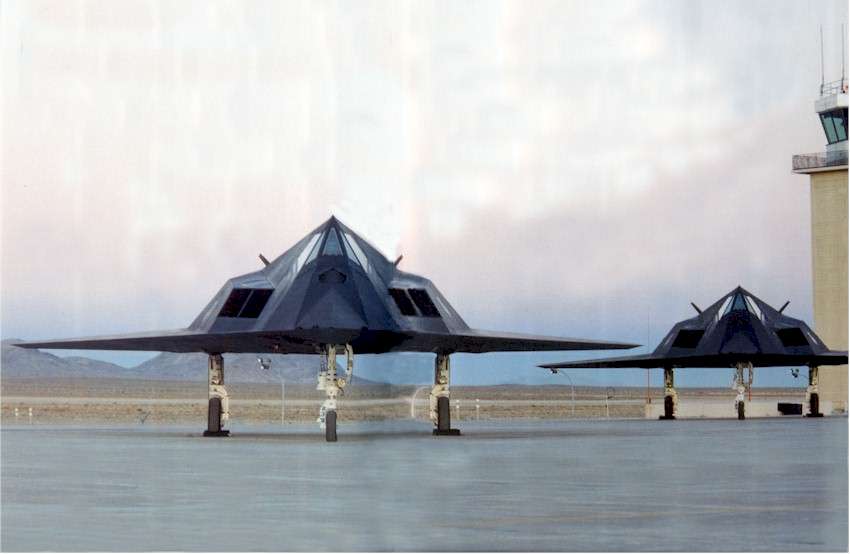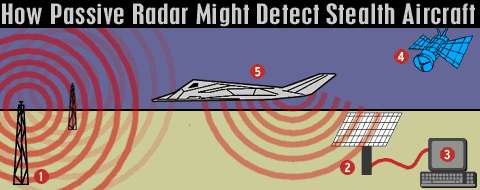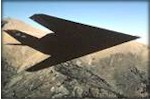The Death of Stealth
Lockheed F-117A NighthawksBeing a stealth pilot is one of the most labor-intensive and time-constrained types of flying that I know. - Lieutenant Colonel Miles Pound USAF
Lockheed F-117A Nighthawks, the world's first operational aircraft fully to exploit stealth technology Intended primarily to penetrate dense enemy environments at night, and attack high-value targets with great accuracy, the F-117A was designed to overcome seven signatures that could otherwise give away its position to an enemy, namely radar, infra-red, visual, contrails, engine smoke, acoustic and electromagnetic emissions, thereby remaining virtually "invisible" and undetectable. The most obvious feature is its almost "lifting body" facetted airframe, comprising many angled skin plates intended to reflect an incoming radar beam away from its source, assisted by radar-absorbing edges and coatings. The possibility of infra-red detection is reduced by the use of non-afterburning engines and efflux cooling, above-wing air intakes and shielded exhaust nozzles of "platypus" slot type that hasten contrail dispersal. In 1996 some 53 F-117As remained in USAF service. Source: The World's Strangest Aircraft: A Collection of Weird and Wonderful Flying Machines by Michael Taylor
New "Passive" Radar, under Development by Russia and China, Could Threaten Stealth Aircraftby John McWethy China, Russia, and several European and US companies are working on a new type of radar that could be used to make America's premier stealth aircraft far more detectable, intelligence sources. The cutting-edge work threatens to make today's most advanced stealth planes obsolete - the $40 billion fleet of B-2 bombers that saw its first action just two years ago in the air war over Kosovo and the older $6 billion fleet of F-117s. "In the end you may have to redesign your stealth aircraft or think about adding jamming or other countermeasures," says Dan Goure, a former Pentagon official who is a senior fellow at the Lexington Institute in Arlington, Virginia. hat could cost billions of dollars. And the new radar also could put US pilots in non-stealth aircraft at risk. In highly classified intelligence assessments, analysts worry that Iraq - with help from China - could be laying the groundwork for building such a system. That would pose a new and deadly threat to US and British pilots who patrol Iraq's "no-fly zones" and are regularly fired upon. "Passive" Radar Is Stealthy
Of immediate concern is that this so-called passive radar can also track all types of aircraft without the pilots knowing they are being watched or targeted. With conventional radar, pilots know when they are being tracked and can take appropriate action. Conventional radar sends out its own high-frequency signal that a pilot can detect. The new radar simply listens to low-frequency radio waves that are already in the atmosphere in great profusion, from power sources such as transmitters used for television, FM radio and cell phones. "And because there are quite a large number of transmitters that they can use for that purpose, it's quite effective," says Professor Hugh Griffiths of University College London. Spread of High-Performance Computers
"If you have not only the ability to do this kind of detection passively, but also to communicate the data to your military units, the way we use air power is going to have to change," says Goure. "We are simply not going to own the skies in the same way. "We have the potential in fact for a revolution in air defense and the reason it is such a revolution is because of what's changed in computing power," he says. "Not only computing power, but access to computing power and software by almost any nation in the world." It hasn't happened yet, but intelligence sources say the race is on. And what is likely to guarantee widespread use of passive radar is cost. It is expected to be much less expensive than today's high-frequency systems. Air Force officials say they are watching these developments closely and insist they are already anticipating ways to deal with them. Source: ABC News 14 June 2001; small photo credit Staff Sergeant Andy Dunaway/US Air Force
To view other articles related to flying including history, unusual flying machines, hot air balloons, skydiving, gliding, problems, airports, turbulence, pilots, crashes, the Paris Air Show, the
future, blimps, space travel, solar sails and more, clicking the "Up" button below takes you to the Table of Contents for this section on Flight. |
 Animals
Animals Animation
Animation Art of Playing Cards
Art of Playing Cards Drugs
Drugs Education
Education Environment
Environment Flying
Flying History
History Humour
Humour Immigration
Immigration Info/Tech
Info/Tech Intellectual/Entertaining
Intellectual/Entertaining Lifestyles
Lifestyles Men
Men Money/Politics/Law
Money/Politics/Law New Jersey
New Jersey Odds and Oddities
Odds and Oddities Older & Under
Older & Under Photography
Photography Prisons
Prisons Relationships
Relationships Science
Science Social/Cultural
Social/Cultural Terrorism
Terrorism Wellington
Wellington Working
Working Zero Return Investment
Zero Return Investment

 The breakthrough that is making this possible is the use of new high-speed computers to sort through the clutter
of signals, picking out those radio waves that are bouncing off moving objects in the air.
The breakthrough that is making this possible is the use of new high-speed computers to sort through the clutter
of signals, picking out those radio waves that are bouncing off moving objects in the air.